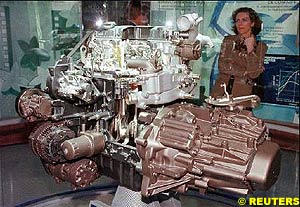

Automotive News and Reviews for the Petrolhead
Reuters Motoring Commentator
In this week's issue:
- Clean Diesels Tempt Peugeot and Ford
- Why the Avantime is a Car of Contradictions
Peugeot Citroen and Ford have unveiled what they call the cleanest diesel engines ever made, the latest phase of a joint plan aimed at exploiting booming European demand for diesel cars.
The French and U.S. firms are investing almost one billion euros between 2001 and 2003 to develop two new diesel engines in eastern France, which they said will make them the world's number one maker of the cleaner, more efficient motors.
"Diesels used to have a bad name - noise, smell and lack of performance; that's now history," Derrick Kuzak, vice president of product development for Ford Europe, told a joint news conference in Paris. "Diesel now accounts for 40 percent of the European market and is rising."
PSA and Ford said they would make some 1.6 million per year of the new 1.6-litre and 2.0-litre diesel engines by 2005, which they said were among the cleanest engines ever made because they gobbled up less fuel than petrol cars and some were fitted with a special new filter.
The launch of these two new engines is the second phase of a four-pronged plan to drive the firms to the forefront of diesel technology and to meet burgeoning demand in Europe. Companies lagging in the top-selling technology, such as the Opel unit of General Motors, have suffered from a slowdown in sales and are now struggling to catch up.
World Leaders
PSA and Ford said production of the engines had already started at PSA's Tremery plant in eastern France and would be powering models of both firms by the second half of this year. Some 37 different vehicle versions would eventually feature the new engines.
The 1.6-litre engine is a bigger version of the two firms' 1.4-litre motor already in production at Tremery and already used in small PSA and Ford cars. With the 2.0-litre engine, the companies aim to boost performance without consuming more fuel.
"These engines have allowed us to boost performance and appeal, improve security, reduce noise and keep fuel consumption to a minimum," said project director Pascal Lefebvre, adding the motors were "the cleanest engines ever made".
The two firms, which launched the cooperation plan in 1998 and enlarged it in 1999, said total investment in the project so far, including the latest amount, was 1.4 billion euros.
"Thanks to this strategy, the two groups will in the short term be the world's top makers of diesel engines," said Gilles Michel, PSA's platform, technical and purchasing director.
Kuzak said Ford was mulling how to develop diesel technology in its key U.S. market but declined to give details. The joint venture illustrates PSA's strategy of pursuing cooperation deals with other manufacturers on specific projects rather than taking equity stakes in other companies.
The Renault Avantime is stark-raving bonkers.
You realise this as you drive along your local High Street with people staring open-mouthed at you. Old ladies drop their bags of shopping, fearful (hopeful) that Cyborgs have arrived to bodysnatch them. Children point and laugh, bewildered as to how the picture they drew at school today has been so quickly (and accurately) brought to life. And white van man just stares, unable to stifle the belief that the driver must be 'in the arts' if you know what I mean...
Glancing through the PR notes Renault kindly supplied with the car, it would seem that they are none too clear either. "Not only does the Avantime offer another choice to the executive coupe customer," they begin, "but it will also catch the eye of buyers looking for a replacement for their 4x4, those who no longer need an MPV, or executive saloon owners who still want to occasionally use the rear seats." So pretty much everyone then, except old ladies and builders (children may well gawp and smirk, but secretly they desperately want an Avantime). This is what makes manufacturers such as Renault special, of course: the ability to build idiosyncratic one-offs, cars that, relatively speaking, make no particular sense.
In fairness, the Avantime makes plenty of sense, in plenty of ways but Renault's suggestion that it is a GT Coupe is just plain silly. Even in a broad-minded, looking-to-the-future sort of way, the Avantime is not a GT Coupe. But it could be argued that it is an MPV Coupe. The MPV (multi-purpose vehicle or 'people carrier') is an automotive nadir for many people. For men, it represents the point at which they finally, grudgingly accept that the opposite sex is no longer likely to look at them once, never mind twice. The (more practical) opposite sex accept that common sense must prevail and 'isn't it nice that the children can see so much from the elevated seating position'.
So maybe the Avantime is the answer for those among us who do want the interior space, the high seating position, the load carrying capacity and the multi-purpose practicality (but don't need more than four/five seats).
Power and Performance
The driving experience is certainly that of an MPV and the high seating position, a long way back from the windscreen, will be familiar to anyone who has driven a Renault Espace. The combination of sizeable front and rear overhangs and the tall, heavy body lend the car a wallowing gait although the power provided by the 3.0 litre V6 still allows for rapid progress to be made. This is why Renault has labelled the car a GT Coupe; GT has always stood for Grand Tourismo, or Grand Touring, and in fairness, the Avantime can eat up the miles with comfort and ease. But in the purest sense, a GT Coupe also engenders engaging handling and sporting sensibilities. The Avantime has all of the power and performance but, in truth, none of the poise.
Above the waistline, the Avantime is almost exclusively glass. There are no B pillars between the doors and rear windows, the panoramic windscreen slopes away to a disappearing bonnet line in true MPV fashion and the shallow rear window wraps into the broad, carriage-like rear pillars. Front and rear seat passengers sit beneath two glass panels in the roof, the most forward of which slides open electrically and is claimed to be the largest panoramic sunroof available on a car. Both panels are made from Venus glass to absorb the sun's rays without cooking the Avantime's occupants in the process and there is also a handy, one-touch feature that will automatically open all windows and roof panel simultaneously.
The cabin itself is yet another of the car's contradictions. As is vogue, particularly with French manufacturers, the Avantime has a centrally positioned digital driver information centre (formerly known as a dashboard). The principle of these is excellent: right-hand drive and left-hand drive markets can essentially be provided with the same car and, when done well, they do provide the vehicle with a more egalitarian sense of inclusion. Even rear-seat passengers can see the engine temperature level.
Dashboard Dangers
Renault are past masters of 'central' and 'digital' and whilst the Avantime cabin incorporates many typically impressive touches (column-mounted audio controls, individual climate-control panels for driver and front seat passenger, cunningly located cubby holes everywhere) the overall feeling, particularly the forward-facing view, is rather disappointing. Ignoring the so-so build quality (which just didn't seem to be of modern Renault standards, let alone approaching a Germanic level) the entire dash area felt untidy.
Part of the problem can be attributed to the fact that our test car was fitted with the optional (and capable) satellite navigation system, the screen for which is housed in an unsightly carbuncle in the centre of the dash. Annoyingly, the controls are located low down on the centre console, tucked underneath the dash, fore of the gear-shift lever. To use this system on the move is plain dangerous, the high seating position making it impossible to reach the controls without being distracted from the road ahead.
The Avantime isn't cheap (£28,450 for the model we drove, plus extras) but it is different. As with anything out of the ordinary, you can't have it both ways. You either stand out from the crowd and make a statement or you blend into the background. There is no in-between. Accept this Renault for the flawed but distinctive wagon that it is or, chances are, well... chances are, you've already made your mind up.
![]() Clean Diesels Tempt Peugeot and Ford
Clean Diesels Tempt Peugeot and Ford
 Diesel engines have already proved a winner at Peugeot Citroen (PSA), helping the firm boost sales in 2002 and cruise past sputtering European rivals and the two firms said they hoped eventually to swell joint production to some three million engines per year.
Diesel engines have already proved a winner at Peugeot Citroen (PSA), helping the firm boost sales in 2002 and cruise past sputtering European rivals and the two firms said they hoped eventually to swell joint production to some three million engines per year.
![]() Find Out Why the Avantime
Find Out Why the Avantime
is a Car of Contradictions
 But apparently beauty is in the eye of the beholder and at least the Avantime is actually something to behold. We can be pretty sure that Renault wasted no francs whatsoever on customer focus clinics before boldly going where car designers have never gone before. The Avantime is a car of contradictions: ungainly yet well proportioned; modern and futuristic with quaint turn-of-the-century landaulette styling (around the rear); the most handsome carbuncle on the road, perhaps? But what actually is it?
But apparently beauty is in the eye of the beholder and at least the Avantime is actually something to behold. We can be pretty sure that Renault wasted no francs whatsoever on customer focus clinics before boldly going where car designers have never gone before. The Avantime is a car of contradictions: ungainly yet well proportioned; modern and futuristic with quaint turn-of-the-century landaulette styling (around the rear); the most handsome carbuncle on the road, perhaps? But what actually is it?
 It is at this point that the Avantime begins to make the most sense. Windows closed, the extensive glass area certainly affords the car excellent all-round visibility (perhaps with the exception of the narrow rearward view at night) but you do feel a bit like one of the Banana Splits, sat plum in the centre of a motorised goldfish bowl. With the windows and roof open on a sunny day, the cabin acquires a joyous sense of freedom and fun. You still feel a bit like a Banana Split, but it somehow doesn't matter any more.
It is at this point that the Avantime begins to make the most sense. Windows closed, the extensive glass area certainly affords the car excellent all-round visibility (perhaps with the exception of the narrow rearward view at night) but you do feel a bit like one of the Banana Splits, sat plum in the centre of a motorised goldfish bowl. With the windows and roof open on a sunny day, the cabin acquires a joyous sense of freedom and fun. You still feel a bit like a Banana Split, but it somehow doesn't matter any more.
© 2007 autosport.com . This service is provided under the Atlas F1 terms and conditions.
|
Volume 9, Issue 9
Articles
Montoya & Williams: Can They Challenge?
Reflections on Mosley's Brave New World
Pencils at Dawn
The Cult of a Personality, IV
2003 Season Preview
2003 Drivers Preview
2003 Teams Preview
2003 Technical Preview
The 2003 Atlas F1 Gamble
Columns
Off-Season Strokes
On the Road
Elsewhere in Racing
The Weekly Grapevine
> Homepage |